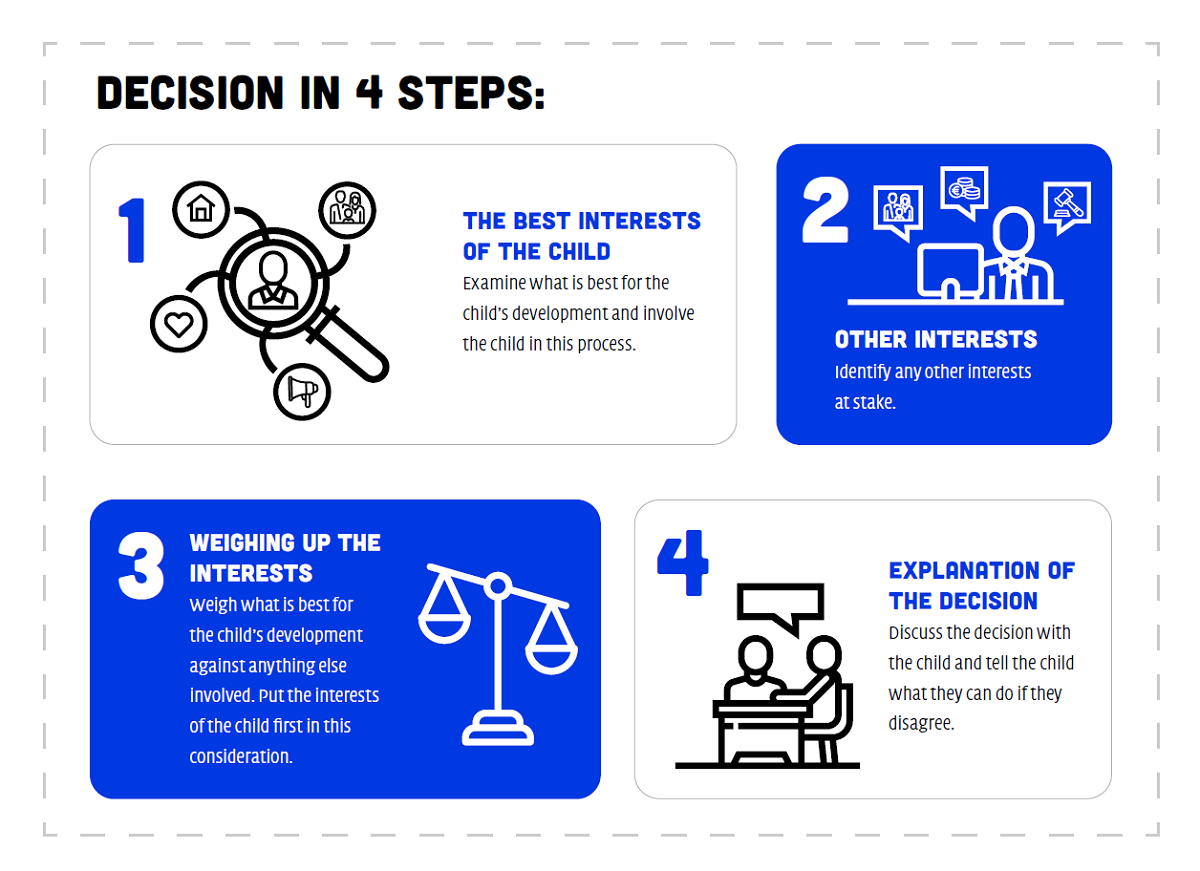As a professional, how do I use these steps in my work?
A decision in 4 steps

If we'd had a plan like that, we might have built in breathing space for difficult decisions.
Participant in pilot implementation guide and Step-by-Step Plan
What's the best approach to a decision in 4 steps? Get started with the Best Decision Step-by-Step Plan!
1
Best interests of the child
Investigate what is best for the child's development and involve the child in this process.
The Committee on the Rights of the Child wants all professionals and institutions to use the same methodology to investigate what is best for the child. This involves examining the specific characteristics of the child, their family and living environment. The Committee has drawn up the following checklist based on articles from the Convention on the Rights of the Child.
The following seven points must always be included in your research:
- Identity of the child
Who is the decision really about? Take the child into account, including their faith, culture, gender and age. - The child's opinion about the situation and the decision to be made
What does the child want and why? - Maintaining the family environment and important contacts
What does the decision mean for who the child lives with and for the child’s contact with people who are important in their life? - Care, protection and safety
What impact does the decision have on the protection, care and safety of the child? - Vulnerable children or special situations
How should additional details such as disability, trauma, social status or a low or high IQ be taken into account? - The child's right to good health
What does the decision mean for the health of the child? - The child's right to education
What influence does the decision have on getting appropriate education?
Based on your research, in this first step, you determine what is best for the development of the child, regardless of everything else. In doing so, you estimate the consequences of the decision for the child's future, both in the short and long term.
Is this difficult to achieve?
If this is difficult to achieve, use our tools for your investigation together with the child, such as the Questionnaire: What do I find important? In this way, you and the child can investigate their situation and find out what they find important.
Based on your research, in this first step, you determine what is best for the child's development, regardless of everything else. In doing so, you estimate the consequences of the decision for the child's future, both in the short and long term.
Best interests of the child
Less information aboutBest interests of the child
2
Other interests
Identify any other interests at stake.
In addition to the child's interests, you have other interests to consider. For example, what the wishes of the parents are, what any organisations involved want and whether there is enough money for the desired solution. There may also be laws and regulations at play that form an obstacle to the best solution for the child. Make an overview of all the 'non-child interests' that you must take into account when making your decision. These may go against the best interests of the child.
Other interests
Less information aboutOther interests
3
Weighing up the interests
Weigh what is best for the child's development against anything else is involved. Put the best interests of the child first.
Once it is clear what is best for the child or their development and what other interests are at play, you can work out several possible decisions based on this information. When you subsequently make a decision, you should also clearly explain why you have made that decision. Mention in your motivation all the factors you have taken into account and how you have weighed them against each other. Also, map out how the best interests of the child are reflected in your decision. If the decision you have made is not the best one for the child, you have to provide additional motivation for your choices. Is there really no other way?
Weighing up the interests
Less information aboutWeighing up the interests
4
Explaining the decision
Discuss the decision with the child and tell the child what they can do if they disagree.
Explain every important decision to the child in understandable language. Don't just explain what decision you are going to make, but also how you have come to the decision and how you have taken the child into account. If the child disagrees with a decision, tell them if there is anything that can be done against the decision and if so, what the child or their parents can do about it.
Explaining the decision
Less information aboutExplaining the decision
Step 1 helps to really see the child and not just the problem the child has.
Laura van den Heuvel, Children's Ombudsman team
If you have any doubts or need help, the Children's Ombudsman will be happy to think along with you. Call us free of charge on 0800 8765 432 or send an email to ombudswerk@dekinderombudsman.nl.
